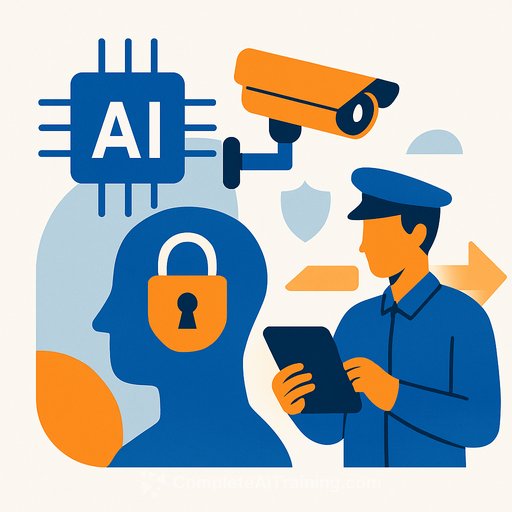AI at the Edge: Transforming Real-Time Security Response
July 29, 2025
This article explores how AI edge computing is changing real-time physical security by processing video and sensor data right at the source. Part 1 focuses on edge-enabled solutions from Actuate, Alcatraz, and Ambient.ai.
AI edge computing means running AI algorithms close to the cameras and sensors ("the eyes and ears") rather than relying solely on cloud processing. This setup allows instant pattern recognition for security threats, faster than human reaction times. The workload is distributed across cameras, local appliances, servers, and cloud platforms to balance speed and scale.
AI and Edge Computing in Security
Placing AI processing near cameras and audio sensors enables real-time analysis of security incidents. This reduces delays and bandwidth demands compared to cloud-only solutions. The AI models learn to recognize threat patterns and can act immediately on-site, allowing quicker and more accurate responses.
The article highlights various AI-enabled security technologies, emphasizing their use of edge AI. It does not detail every feature but explains how each solution integrates with or complements AI at the edge. Special attention is given to privacy and data handling in the Alcatraz section, as these remain confusing areas for many security professionals.
Challenges with Traditional Surveillance and Monitoring
Earlier alarm monitoring systems often struggled with two main issues: false positives (alerts for non-threats) and false negatives (missed real incidents). High false positive rates commonly lead to operator fatigue in monitoring centers, reducing overall effectiveness.
Improving Security Response with AI
The solutions discussed here aim to drastically cut down false positives while avoiding missed threats. They support a range of monitoring approaches suited for diverse environments—from central alarm monitoring to enterprise situational awareness and small business protection. These AI solutions can integrate with existing security systems, making upgrades practical and cost-effective.
- Large-scale third-party or central alarm monitoring
- AI edge readers for multi-sensor access control
- Enterprise-grade, real-time site awareness
- Video intelligence tailored for specific scenarios
- Protection for small and medium businesses during all hours
Actuate: Accuracy Beyond Object Classification
Actuate supports over 13,000 U.S. monitoring stations, serving small businesses and homes with intrusion, fire, video surveillance, access control, and environmental monitoring. Moving beyond traditional reactive monitoring, Actuate’s cloud-based AI video analytics turn monitoring centers into advanced command hubs.
Their AI detects intruders, weapons with 99% accuracy, fires earlier than traditional sensors, and critical crowd formations. It integrates smoothly with most cameras, network video recorders (NVR/VMS), and monitoring platforms.
Reducing False Alarms
Unlike typical motion or object detection that prioritizes missing no threats but triggers many false alarms, Actuate’s AI applies context-aware processing. This lowers false positives by over 95% without missing real threats. One center reported a 57% alert reduction per site, equating to 400,000 fewer monthly alerts.
Actuate supports both live video streaming and workflows where edge AI in cameras or NVRs send images via email alerts using SMTP. This flexibility suits sites with bandwidth limits or existing email-based processes. Their AI models maintain consistent accuracy across live streams, clips, and images.
While Actuate’s system doesn’t rely solely on AI edge computing, edge AI in cameras or recorders acts as a first filter. These edge systems can be tuned for zero missed detections, leaving Actuate’s cloud to minimize false positives during further analysis.
Alcatraz: Privacy-Focused Edge AI for Access Control
Alcatraz offers frictionless facial authentication with the Rock product line, allowing users to access facilities without stopping to present badges or enter PINs. Their devices use AI-powered 3D sensing and facial modeling to authenticate users passively and detect tailgating in real-time—an uncommon feature in access readers.
Understanding Authentication and Authorization
Physical access control has two key steps:
- Authentication – verifying the user’s identity
- Authorization – determining what the authenticated user is allowed to do
Authentication methods include PINs, card scans, facial scans, fingerprints, gait analysis, and voice recognition. Biometric data collected during enrollment is classified as personally identifiable information (PII) by U.S. standards like NIST and the Department of Defense.
How Alcatraz Handles Privacy
Alcatraz does not store facial images. Instead, it creates a mathematical facial template that cannot be used to reconstruct a person’s likeness. This template functions only within their access control system and is encrypted both at rest and in transit.
Key privacy points:
- The template cannot reveal or recreate the face.
- It is only used for authentication within the system, not for broad surveillance.
- Encrypted templates cannot be interpreted by outsiders.
- No PII is shared between Alcatraz and other systems; data is segregated and encrypted.
This approach meets privacy regulations including BIPA (Illinois), CCPA (California), and GDPR (EU). The system requires explicit user enrollment and consent, and does not perform mass identification or tracking.
All AI and analytics run locally on the Rock devices, meaning facial images never leave the device. This is a clear use of cloud-managed AI edge computing. The Rock devices integrate with existing access control systems through standard protocols like Wiegand and OSDP, allowing upgrades without replacing existing equipment.
Ambient.ai: Enterprise-Level Risk Detection
Ambient.ai’s cloud platform aims to detect threats early and send actionable alerts to onsite security teams. It is built for large, high-security environments requiring strict compliance.
The system analyzes all camera feeds continuously using over 150 evolving threat signatures. This adaptive model achieves zero missed threats, eliminates 90%+ of false positives, and alerts on risks as soon as they can be identified.
Ambient.ai integrates fully with enterprise security operations, including GSOC workflows, access control, alarms, and incident responses. Alerts come with detailed context and access to live video, enabling informed, rapid reactions.
The platform uses on-premises AI edge servers to process video streams locally. When threats are detected, compact event data is sent to the cloud for deeper analysis and event correlation. This helps identify patterns across cameras and systems that might indicate larger incidents or repeated violations.
Examples of correlated events include doors held open too long, tailgating, suspicious badge scans, or intrusion alarms. Correlation over time flags whether these events are related, supporting smarter responses like automated lockdowns, lighting activation, or two-way audio with trespassers.
This hybrid edge-cloud setup supports high camera volumes and activity, ensuring timely, well-informed security responses.
For those interested in expanding their knowledge of AI applications in security and other fields, resources such as Complete AI Training offer practical courses and certifications.
Your membership also unlocks:






